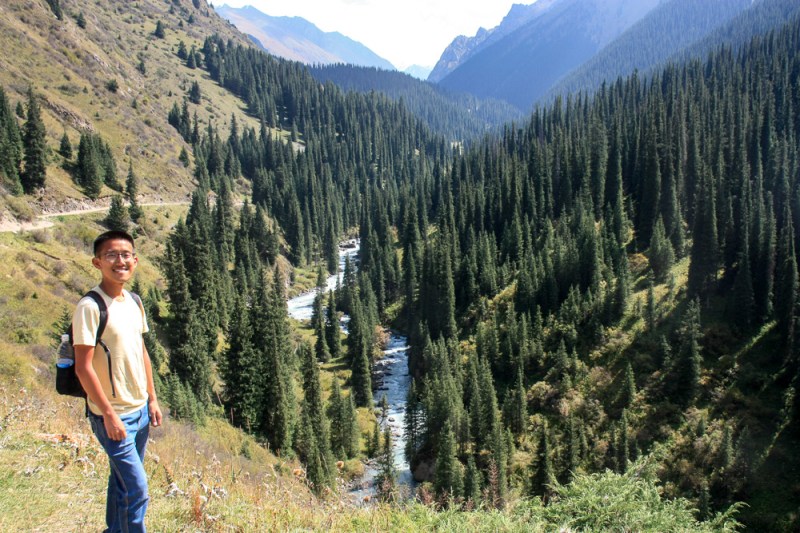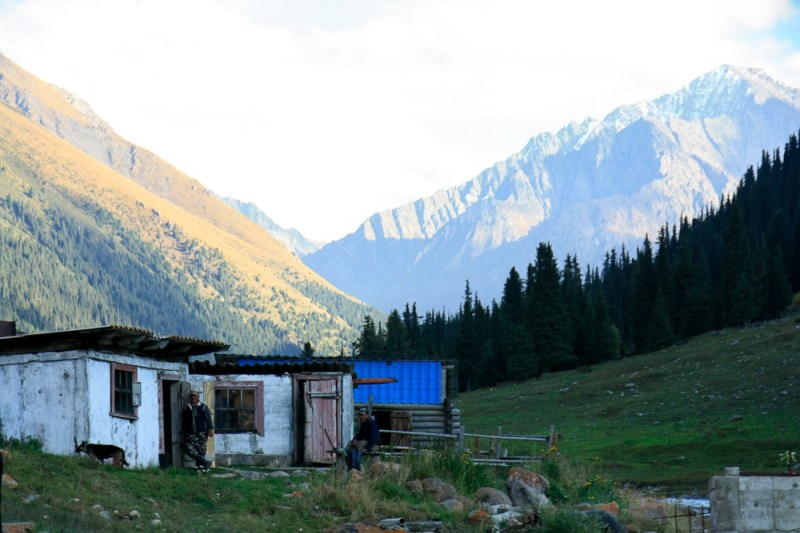 Southern Issyk-Kul, Kyrgyzstan
Southern Issyk-Kul, Kyrgyzstan
The World Nomad Games gave me a small taste of the scenery of Issyk-Kul, and with the games over, I was eager to explore it some more. With plenty of tourists bunched together, the day after the closing ceremonies, all heading in the same direction — a bit of a rarity in this part of the world — it was remarkably easy to group up for virtually any activity, whether lakeside or off to a jailoo.
Issyk-Kul is the 10th-largest lake in the world by volume, and the second-largest alpine lake in the world after Peru/Bolivia’s Lake Titicaca. It may not look like much on a map, but its deepest point is 668m — pretty crazy! I had a quick swim between kok boru matches back in Cholpon-Ata, and was itching for a few days by the lake, but with the tail end of summer approaching, I decided to wait a little longer, and do a bit of mountain hiking before the weather got too cold.
The Issyk-Kul region seems markedly less Kyrgyz than the rest of the country (save for internationally-minded Bishkek), with people from Siberia (Russia) and Kazakhstan having a prominent presence, not just as vacationers, but as long-term residents as well. After all, with the only other large body of water in proximity being the Arctic Ocean far to the north, it’s the only bearably swimmable body of water they’ve got! But surprisingly for a place like this, much of the lake shore is underdeveloped, dotted with humble villages, the odd small resort, faded and few tourist shops, and occasional run-down or abandoned settlements.
I first based myself in Karakol (not a lake), the largest city in the region, for a few days. It’s a pleasant enough place with a small bazaar, one small main strip, and quaint Russian houses with bright window panels and overgrown yards forming the neighbourhoods. There’s also a Russian Orthodox church, standing out from every other building with its colourful exterior.




Similarly sticking out is the Dungan mosque — Dungans are the name for Hui people outside of China, and they form a notable presence here in north/eastern Kyrgyzstan, relatively close to China. While visiting the mosque, I was invited to sit and chat for awhile with a few Dungans, and eventually invited to an elderly man’s home for a meal celebrating Eid al-Adha. While the conversation got quite awkward when it veered suddenly toward the political realm and reach of Russia — which is looked upon very favourably in ex-Soviet Central Asia — I very much appreciated their hospitality. And I did learn something quite surprising — Dungan people speak their own language, which is based on Chinese, but written in Cyrillic. Still, when I tried some Mandarin on them and they tried some Dungan on me, we were maybe only 10-20% mutually intelligible!

While Karakol isn’t exactly a place of interest in its own right, it’s set in front of a gorgeous backdrop of the Tian Shan (Chinese: 天山, Kyrgyz: Ala-Too) mountain range, which is the main attraction that draws in plenty of hiking tourists. I first did a day hike via a combination of luck, marshrutkas, and hitchhiking to the unexpectedly difficult-to-reach (unless you have money for a taxi) Jeti-Ögüz to check out its namesake “Seven Bulls” canyon formation, and wandered in further along a scenic river to find Kök-Jaiyk (Valley of Flowers), a beautifully lush jailoo — though I was a few months late to see those wildflowers.




The crowd-favourite hike in the Karakol area is the three- or four-day loop to Ala-Kul, a deep turquoise lake high up in the mountains known for turbulent weather, with snow even in the height of summer. Unfortunately, with no cold-weather clothing or camping gear (or experience!), I opted out of that hike, and instead grouped up with fellow-Canadian Matt and chose to do an overnight hike to the loop’s final stop, Altyn Arashan.
Altyn Arashan is a burgeoning hot springs development a mere twenty-something kilometres from Karakol. You could drive there… on what my guidebook describes as a candidate the world’s worst road. Walking up the 15 km from where the marshrutka dropped us off, it’s pretty easy to see why. Seeing a truck inexplicably horizontal across the “road” of loose rocks, with a 4×4 stuck while trying to pass it? Affirmation.



Nonetheless, the hike was relatively easy, offering a generous view of the river valley, first beside us, then below. The village of Altyn Arashan itself is incredibly scenic, with a snow-capped mountain in the background of green hills and a river. We hardly deserved the hot springs given the little work we put in, but it was such a lovely atmosphere that we decided to stay two nights, and I took full advantage of that, soaking inside a hot spring cabin every time I felt even the slightest bit cold — which is extremely often — over three days. We were occasionally joined by locals, who would soak in the toasty, sulphuric water for just a few minutes, before running into the ice-cold river for a quick dip before heading back into the hot spring again. We tepidly gave it a try, and despite the initial howls and screams, found it refreshing enough to incorporate it into routine!







Our second day there, we attempted to hike to two nearby lakes at a lower (and warmer) altitude, but found ourselves lost after three hours due to a missed turn, with two hours to walk back to where we started. Pleasant, but no payoff. Other than grazing animals, we did see and walk what was probably the largest meadow I’ve ever seen in my entire life…




After returning to Karakol for one more night and cleaning up, we headed to Bokonbayevo, home to a lakeside yurt camp in the nearby village of Ton — alas, beach time! Issyk-Kul, meaning “warm lake”, never freezes even in the dead of winter due to its slightly saline properties, unusual for a non-oceanic body of water. Not only that, as I mentioned before, it’s huge, and with a slight breeze, it even has waves. Our three-day stay had the odd feeling of sleeping in a yurt to the sight and sounds of the ocean with faint, snow-capped mountains in the distance on the north side. Coupled with some beach shack-like structures at the yurt camp, it was like “Kyrgyzstan meets the tropics meets winter”. It makes no sense, and yet it totally does, and we had a lovely time enjoying the water (though getting out was slightly cold!), reading by the lake, and stuffing our faces full of delicious, limitless plov in the dinner yurt every night.






Some of the other guests at the yurt camp had arranged for a local hunter to do an eagle demonstration right at the camp, and we were free to watch. Standing at the top a nearby hill with his eagle, his son/assistant stayed on the ground with us, first dragging a lure like the burkut saluu event at the Nomad Games. But in a second demonstration, the assistant pulled a live hare out of a bag, throwing it onto the ground. Nonchalantly clueless, the hare lost its life in a matter of seconds, as the eagle swooped down, picked it up, and tore into it upon landing in front of our eyes. Yikes!



The hunter described a bit more about the tradition, passed down from his father and soon to be passed down to his son. The large golden eagles that they keep live to around 60 years old, but are only kept for a maximum of 20 before being released to live out the rest of its days. Fiercely loyal, they’re first captured and tamed by the hunter using easy prey like marmots to fatten it up and slow it down. Over time and after training, the eagle accompanies the hunter on horseback, able to catch six or seven foxes (by the jaw!) per year, among other creatures. In addition to providing meat (some of which it eats itself), the eagle has no interest in fur and leaves it intact. Pretty convenient for the hunter!
The next day, along with Lukas (Switzerland) and Mathieu (France), we arranged transport to the Skazka (“fairy tale”) Canyon. With jagged spires and shades of red, orange, yellow, white, pink, and brown, it definitely lives up to its name — and even more so for its maze-like unpredictability, which led to us getting lost for awhile, climbing up and down some very steep, thorn-laden hills that led us to dead ends but spectacular views of the canyon (surprisingly small), the mountains and grasslands on the other side, and the lake (a surprisingly vivid shade of blue). We emerged… mostly unscathed, stopping by an oddly-situated hotel hot spring (more like a pool of hot water) before returning to the yurt camp.






On our last full day, Matt and I decided to do a little walking around the village of Ton. We quickly found more than we bargained for when we greeted a Kyrgyz man walking down the street, who — speaking Kyrgyz and barely any Russian — basically dragged us into his house, kissed our cheeks frequently and profusely, insisted we stay in his guest room (we declined), called me Vietnamese constantly despite my many corrections, offered us bread and meat, stuffed my backpack with apples (giant, surprisingly fragrant, and delicious) and a head of corn all from his backyard despite our objections, then asked for 50 som ($0.80). Ooookay. Unable to communicate, we paid and walked away as fast as we could.


Still, hospitality! And in a small village like Ton, we were warmly greeted by practically everyone who passed by. Despite the stunning lakeshore location, the sandy portion of their beach was sparsely populated, the local factory abandoned, the fire hall covered in cobwebs, and the main “street” distinguished by a near-complete lack of shops. And yet… their school is new, each household either has a ton of apple trees or has some sort of large-scale farming equipment on hand, and residents are out and about. Like much of Issyk-Kul, there’s so much potential for large-scale tourism. It’s perplexing but admirable that they’ve just kept their quaint lives instead.

